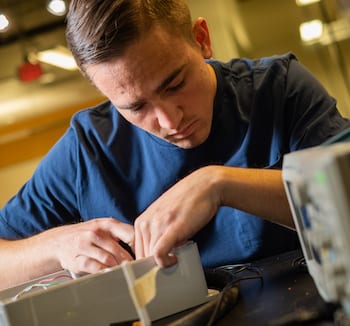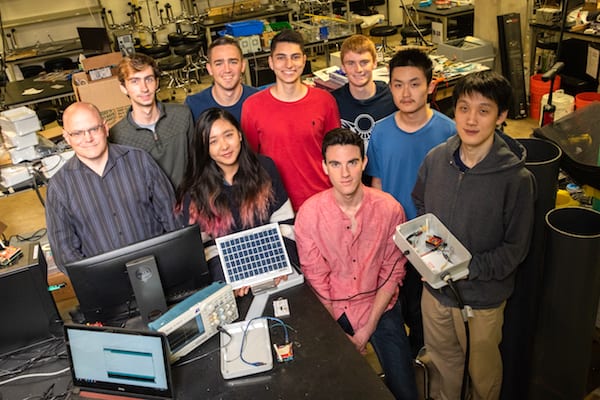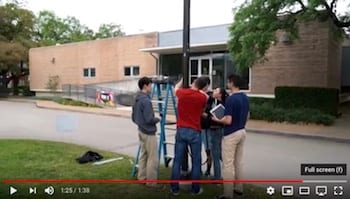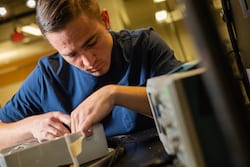NEWS RELEASE
Editor’s note: Links to video and high-resolution images for download appear at the end of this release.
David Ruth
713-348-6327
david@rice.edu
Mike Williams
713-348-6728
mikewilliams@rice.edu
Rice U. students focus on floods
Engineering team develops remote sensors to keep real-time eye on roads and neighborhoods
HOUSTON – (April 4, 2019) – When heavy rains come, as they inevitably do, it will be helpful for homeowners to know when a surge of floodwater is heading their way.
A team of senior engineering students at Rice University is working to make that technology real. They are developing a real-time, web-enabled system to monitor flood levels throughout a municipality like Houston, which has suffered three damaging floods in recent years, topped by the devastation of Hurricane Harvey.
The students have developed a set of wireless stations that communicate with a base to report on flooding at their locations. The stations have several components: A solar-powered wireless transmitter that can ride high atop a utility pole, with a rubber conduit that stretches down the side and connects the station to a water-level rain gauge and pressure sensor, and software developed by the students that gathers data sent by the remote stations and reports on what they see.
A set of sensors spread throughout a city can provide authorities with the information they need to respond to a flood in progress. Initially, the sensor nodes are set to report local conditions every five minutes, but that can be adjusted as needed, according to the team.
Naturally, Houston is interested. For that reason, the Houston Solutions Lab, a partnership between Rice’s Kinder Institute for Urban Research and the city of Houston, is sponsoring the initiative being developed as a senior capstone project at the university’s Oshman Engineering Design Kitchen. Rice alumna Joan Gurasich ’68 is also a sponsor.
The students will demonstrate their work at the annual George R. Brown School of Engineering Design Showcase, at which more than 80 teams will compete for thousands of dollars in prizes. The event will be open to the public from 4:30 to 7 p.m. April 11 at Rice’s Tudor Fieldhouse.

Alfonso Morera, an electrical and computer engineering senior at Rice University, wires a control box at the Oshman Engineering Design Kitchen. The box is one component of a wireless flood monitoring system designed and built by students in collaboration with the City of Houston. Photo by Jeff Fitlow
Senior members of the team – Alexandra Du, Alex Kaplan, Neil Seoni, Alfonso Morera and Kevin Wu – are all electrical and computer engineering majors, and are being advised by Gary Woods, a Rice professor in the practice of computer technology and electrical and computer engineering.
To some degree, Du said, the system mimics that developed by Rice’s Severe Storm Prediction, Education & Evacuation from Disasters (SSPEED) Center to monitor flood levels along Houston’s bayous, but with much less expensive, off-the-shelf components.
Along with the software, the students designed and built several simple PC boards to connect sensors and solar cells to battery packs and a wireless transmitter. But in total, each station shouldn’t cost more than a few hundred dollars, including waterproof casing to protect the electronics – and less if the product is someday made in bulk quantities.
“The individual sensors store and send information to a central location using radio, and that location will then parse through and send the data off through a cellular connection,” Du said. “We can then get that from any web interface.”
Du has a personal stake in the project, as her family’s home in Katy, Texas, was flooded during Harvey.
“Our goal is not so much to measure rainfall, because that’s tracked a lot,” she said. “We are much more interested in water levels on the streets and the movement of that water.”
“We hope this will help tell first responders where there’s the most need and how to allocate their resources effectively,” Morera added.
Woods said the project started when two Rice professors, civil engineer Leonardo Dueñas-Osorio and computer scientist Devika Subramanian, looked in vain for commercial versions of what the students have developed for their own projects. “That’s when we decided to make this a senior design project,” he said.

A team of Rice University students have developed an inexpensive flood monitoring system that can be deployed around a city to help first responders anticipate trouble spots during extreme weather. Members are, from left, adviser Gary Woods and students Justin Bryant, Alexandra Du, Alfonso Morera, Neil Seoni, Alexander Kaplan, Nicholas Lester, Jerry Lin and Kevin Wu. Photo by Jeff Fitlow
Woods said there’s no reason the proof-of-concept can’t be scaled up. “Houston might want to have thousands of these,” he said. “This is all based on ‘internet of things‘ technology, which is getting cheaper all the time.”
The students plan to have a small set of sensors set up around campus by the end of the spring semester, and hope to deploy a larger set in a Houston neighborhood prone to flooding, like Meyerland, over the summer.
The project won’t end there, Woods said. It’s important enough to Rice’s Vision for the Second Century, Second Decade to rise to the level of a Vertically Integrated Project (VIP), signifying projects that require several years to complete and allow for mentorship between faculty, seniors and underclassmen. Accordingly, the three underclassmen who are part of the project — sophomore Nicholas Lester, Jerry Lin and Justin Bryant — will be expected to carry it forward over the next few years.
-30-
Read about the project at http://oedk.rice.edu/Sys/PublicProfile/47721473/1063096
Follow Rice News and Media Relations via Twitter @RiceUNews
Related materials:
George R. Brown School of Engineering: https://engineering.rice.edu
Oshman Engineering Design Kitchen: http://oedk.rice.edu
Houston Solutions Lab: https://houstonsolutionslab.blogs.rice.edu
Video:
Video produced by Brandon Martin/Rice University
Images for download:
https://news2.rice.edu/files/2019/04/0408_FLOOD-1-WEB-v7g8e1.jpg
A team of Rice University students have developed an inexpensive flood monitoring system that can be deployed around a city to help first responders anticipate trouble spots during extreme weather. Members are, from left, adviser Gary Woods and students Justin Bryant, Alexandra Du, Alfonso Morera, Neil Seoni, Alexander Kaplan, Nicholas Lester, Jerry Lin and Kevin Wu. (Credit: Jeff Fitlow/Rice University)
https://news2.rice.edu/files/2019/04/0408_FLOOD-2-WEB-11gp92v.jpg
Alfonso Morera, an electrical and computer engineering senior at Rice University, wires a control box at the Oshman Engineering Design Kitchen. The box is one component of a wireless flood monitoring system designed and built by students in collaboration with the City of Houston. (Credit: Jeff Fitlow/Rice University)
Located on a 300-acre forested campus in Houston, Rice University is consistently ranked among the nation’s top 20 universities by U.S. News & World Report. Rice has highly respected schools of Architecture, Business, Continuing Studies, Engineering, Humanities, Music, Natural Sciences and Social Sciences and is home to the Baker Institute for Public Policy. With 3,962 undergraduates and 3,027 graduate students, Rice’s undergraduate student-to-faculty ratio is just under 6-to-1. Its residential college system builds close-knit communities and lifelong friendships, just one reason why Rice is ranked No. 1 for lots of race/class interaction and No. 2 for quality of life by the Princeton Review. Rice is also rated as a best value among private universities by Kiplinger’s Personal Finance.




